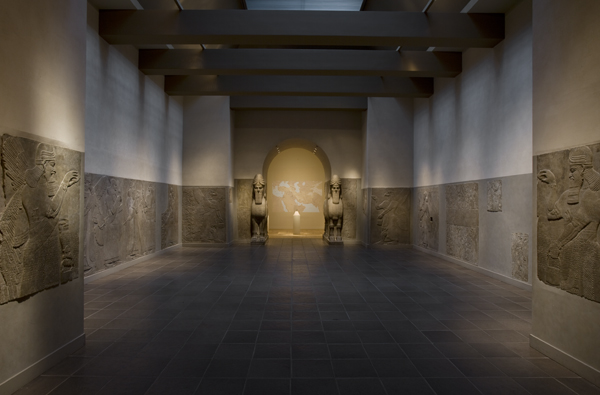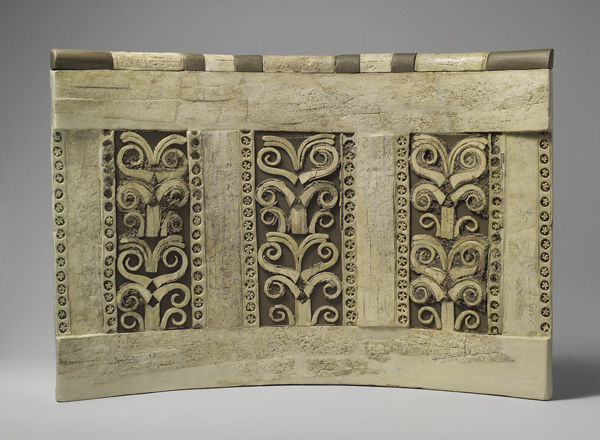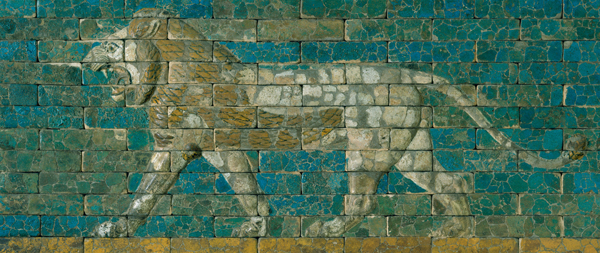Assyria to Iberia at the Dawn of the Classical Age, on view in Gallery 999, includes approximately 260 works of art on loan, which come from 41 museums located in 14 countries, as well as numerous objects from the Museum's permanent collection. Now through January 4, visitors have the rare opportunity to draw connections between the works on view in the exhibition—many of which have never been displayed in North America—and the magnificent objects on permanent display in Galleries 400–406. This blog post highlights some of these connections and is a brief guide to works in the permanent galleries that are of particular relevance to the exhibition.
The Palace of Ashurnasirpal II at Nimrud, Mesopotamia
The reconstruction of an audience hall at the Palace of Ashurnasirpal II at Nimrud, Mesopotamia, in Gallery 401.
In the ninth century B.C., the Assyrian king Ashurnasirpal II moved the royal court from Ashur to Nimrud in what is now northern Iraq, and built a palace unlike any before. State rooms and ritual spaces were arranged around a series of courtyards and the walls were lined with gypsum alabaster relief sculptures. Highlights of the exhibition include a relief from the palace at Nimrud that depicts a winged guardian figure, on loan from Williams College Museum of Art, and a unique statue of Ashurnasirpal II from a temple at Nimrud, on loan from the British Museum.
The Metropolitan Museum's spectacular collection of wall reliefs from the palace at Nimrud, in Gallery 401, depict Ashurnasirpal II and his attendants participating in ritual activities along with supernatural beings that act as guardians of the king and his palace, much like the one shown on the Williams College relief. The reliefs in the permanent gallery emphasize the divine protection of the king, his service to the gods, and his military successes: they are also inscribed with details of the important events of his reign. A pair of colossal winged guardian figures known as lamassu flank one of the entrances to the gallery, alongside the palace reliefs. Both figures have human heads and wings: one has the body of a bull and the other a lion. Such composite human-animal figures were considered to have supernatural powers and functioned as protective guardians: they were placed at gates, doorways, and other locations throughout the palace at Nimrud. These guardian figures, along with the reliefs, dramatically re-create an actual palace room at Nimrud—a visual experience that alone is well worth the stroll down the corridor from Assyria to Iberia.
For more about the Nimrud reliefs in Gallery 401, watch Curator Kim Benzel's 82nd & Fifth episode, Hyperreality.
Ancient Near Eastern Ivories and the Bible
Chair back with a tree pattern. Mesopotamia, Nimrud (ancient Kalhu), Neo-Assyrian period, ca. 8th century B.C. The Metropolitan Museum of Art, New York, Rogers Fund, 1959 (59.107.1). This work is on permanent display in Gallery 400.
Numerous objects in the Assyria to Iberia exhibition reflect biblical stories, including the Tel Dan Stele, a loan from Israel, which is unique due to its reference to the "House of David" in a proclamation of victory by an Aramaean king. The account corresponds to the biblical verses in 2 Kings 9:24–28. Splendid ivory plaques from Samaria, also on loan from Israel, may corroborate the biblical description of the Israelite king Ahab's palace as "adorned with ivory" (1 Kings 22:39). Luxuries such as ivory beds are emphasized and denounced (Amos 6:4). In Gallery 400, the ivory chair back decorated with a tree pattern (shown above) is a prominent example of the royal furniture from the Assyrian palace at Nimrud that resonates with such biblical stories. There are many additional ivory plaques of Phoenician, Assyrian, and Syrian manufacture also on view in Gallery 400, as well as in Gallery 404. Each one is a delicately carved work of art and a furniture element.
Glazed-brick Panels from Babylon, Mesopotamia
Panel with striding lion. Mesopotamia, Babylon. Neo-Babylonian period, reign of Nebuchadnezzar II, 604–562 B.C. The Metropolitan Museum of Art, New York, Fletcher Fund, 1931 (31.13.1). This panel is on permanent display in Gallery 404 along with a second one (31.13.2).
The glazed-brick panels of a dragon (mushhushshu) and a lion from Babylon, on view in Assyria to Iberia, are on loan from the Vorderasiatisches Museum in Berlin, while two additional lion panels are on permanent display in Gallery 404. In 612 B.C., Nineveh was sacked, and Babylon became the dominant power in the Near East, the largest city in the ancient world, and the site of significant palace and temple building projects. The king Nebuchadnezzar II was responsible for the construction of the Ishtar Gate, which was colorfully decorated with glazed-brick figures of bulls and dragons, symbols of the gods Adad and Marduk. Figures of striding lions, the symbol of the goddess Ishtar, lined the walls of the Processional Way, which led from the inner city through the Ishtar Gate to the Bit Akitu, or "House of the New Year's Festival."
Watch Curator Sarah Graff discuss these panels in the 82nd & Fifth episode Bricks.


